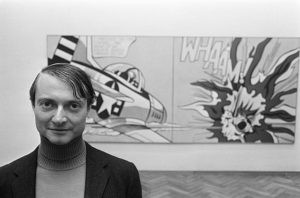Roy Lichtenstein became one of the most prominent names in American pop art in the 1960s, entering the broader cultural consciousness through his paintings resembling comic strips from pulp magazines and noir serials. Today works like Whaam! and Masterpiece are some of the most recognizable examples of the pop art genre and twentieth-century art in general. But even decades after their creation, Lichtenstein’s works are not without their critics, especially when it comes to one of the most pervasive criticisms of pop art: copyright and plagiarism.
Last October, the Supreme Court heard oral arguments in a case where a photographer and the Warhol Foundation are suing each other, with the photographer alleging that Andy Warhol had created his portraits of the singer and musician Prince based on one of her photographs. A new documentary entitled WHAM! BLAM! now looks into accusations of plagiarism from comic artists and illustrators who levy several accusations at Lichtenstein for borrowing, stealing, copying, or otherwise heavily drawing upon their work. About thirty comic artists tell their stories about only being paid a few dollars for each illustration they made, only for Lichtenstein to use their work and earn his fame and wealth. Many of the illustrators interviewed claim they were unaware that Lichtenstein had used their work until the producer James Hussey contacted them. Hussey and others attached to the new documentary have repeatedly made it clear that their goal was not to attack Lichtenstein but rather to “stimulate debate” within the art and legal communities about this matter.
Lichtenstein rarely copied and pasted another artist’s work outright, making changes while maintaining the original idea behind the illustration. But regardless, Hussey found close to three hundred Lichtenstein paintings that bore more than a passing resemblance to the comic book art of the period he created them. Comic book collector David Barsalous has documented hundreds of these instances through the Deconstructing Roy Lichtenstein project, which he has operated since 2000. Through Barsalou’s project, researchers can now see which comic and commercial illustrators whose work Lichtenstein most often borrowed from. These include Ted Galindo, a Marvel illustrator who created the original work seen in Roy Lichtenstein’s most valuable painting, Masterpiece, which Agnes Gund sold through New York’s Acquavella Gallery for $165 million. There’s also John Romita, a Marvel illustrator credited with co-creating the characters of Wolverine, the Punisher, and Mary Jane Watson. Finally, there’s Tony Abruzzo, who mainly created romance comics from the 1950s to the 1970s, providing Lichtenstein with the source material for many paintings, including Drowning Girl, In the Car, and Hopeless.
However, Bradford Collins, an art history professor at the University of South Carolina and author of a book on pop art, argues that what Lichtenstein did was not stealing or plagiarism but rather appropriation. Collins says, “With plagiarism, you’re stealing somebody’s work and using it for the same purpose they did. If Lichtenstein made comic books out of it, that would be stealing. But appropriation means you’re taking something and reusing it for a very different purpose, taking something out of a comic book and making it into a painting.” At this point, it might seem like Lichtenstein’s remaining defenders are splitting hairs and relying mainly on pedantic arguments. But unfortunately, the changes Lichtenstein made and the new context in which he placed his works would be considered “transformative” in many legal settings, meaning technically, the work cannot be officially labeled as plagiarism.
Though Roy Lichtenstein passed away in 1997, his namesake foundation manages his estate, curates his catalogue raisonné, and protects his name, image, and works. The Roy Lichtenstein Foundation even submitted an amicus curiae brief on behalf of the Andy Warhol Foundation in the ongoing case against photographer Lynn Goldsmith. So even though Lichtenstein is not personally profiting from his works anymore, the foundation still licenses the use of his works’ images. Meanwhile, the original cartoonists and comic artists whose work Lichtenstein appropriated are in their 80s and 90s, with some needing to rely on charitable organizations for their food, like in the case of illustrator Russ Heath. While some argue that Lichtenstein’s work helped elevate the art of comic books, others argue the opposite. Maus creator Art Spiegelman claims, “Lichtenstein did no more or less for comics than Andy Warhol did for soup”. But who knows? The upcoming Supreme Court decision involving the Andy Warhol Foundation may open doors for the still-surviving comic book artists whose work Lichtenstein appropriated to receive the credit and financial compensation… or those doors may be closed and locked shut, depending on how things go.

